Summary of the Picos de Europa Lepidoptera Study, 2009
Teresa Farino
03/04/2010 09:05:54
Between February and November 2009 we recorded 115 species of butterfly and 311 macromoths in the Picos de Europa and surrounding area, in the process adding nineteen new macromoths to our list for the region.
Posted in: Butterflies and Moths, Endangered Wildlife and Habitats | Asturias, Cantabria, Castile-Leon | Mainland Spain, Northern Spain
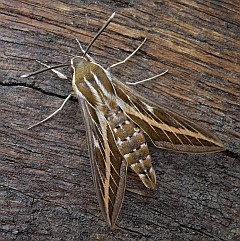 Striped Hawkmoth
Striped Hawkmoth
Hyles livornica© Teresa FarinoLaunched by Teresa Farino in 1989, this study of the butterflies and macromoths of the Picos de Europa is centred on the valley of Liébana, in the south-eastern corner of the range, extending as far south as the Puerto de Piedrasluengas, in Palencia, and to the Valdeón valley in León to the west. In twelve years of serious investigation (since 1998), we now have almost 30,000 records for this area.
In 2009, our surveyors (Teresa Farino, John Barkham, Steve Petty, Marc Botham, Dan Hoare and Ross Piper) made 3,417 field observations – 2,227 of butterflies and 1,190 of macromoths – during 98 days/nights, in 96 1km x 1km UTM squares. Between February and November, we detected the presence of 115 species of butterflies and 311 species of macromoths. These figures represent 74% of the 155 butterflies cited to date as being present in the Picos de Europa, and almost half of the 652 macromoths recorded since this study began.
Butterflies
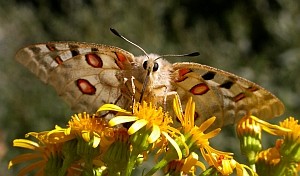 Apollo
Apollo
Parnassius apollo© Teresa FarinoIn general, butterfly numbers in 2009 were considerably higher than in 2008 (see
Summary of the Picos de Europa Lepidoptera Study, 2008). That said, the poor weather experienced during the flight periods of certain high-altitude species produced very few records of, for example, Mountain Clouded Yellow (
Colias phicomone), Gavarnie Blue (
Agriades pyrenaicus asturiensis), Lefèbvre’s Ringlet (
Erebia lefebvrei astur) and Mountain Ringlet (
E. epiphron), although this does not necessarily imply low breeding success. Once again, the Spanish race of Shepherd’s Fritillary (
Boloria pales pyrenemiscens) failed to make an appearance, but Apollos (
Parnassius apollo), which fly a little later in the year, were present in good numbers right through to mid-September.
 Large Chequered Skipper
Large Chequered Skipper
Heteropterus morpheus© Teresa FarinoVery few individuals of a number of middle-altitude and lowland species were also recorded, including Marbled Skipper (Carcharodus lavatherae), Large Grizzled Skipper (Pyrgus alveus accretus), Olive Skipper (P. serratulae), Provence Orange Tip (Anthocharis euphenoides), Western Dappled White (Euchloe crameri), Green-underside Blue (Glaucopsyche alexis), Purple Hairstreak (Neozephrus quercus), Idas Blue (Plebejus idas), Cardinal (Argynnis pandora), Pearl-bordered Fritillary (Boloria euphrosyne), Large Tortoiseshell (Nymphalis polychloros – both the overwintering and summer generations), Spanish Heath (Coenonympha iphioides) and Grayling (Hipparchia semele).
More worryingly, several species that we have observed consistently during the course of the study were conspicuous by their absence: Chequered Skipper (Carterocephalus palaemon), Silver-spotted Skipper (Hesperia comma), Bath White (Pontia daplidice), Baton Blue (Pseudophilotes baton), Camberwell Beauty (Nymphalis antiopa), False Heath Fritillary (Melitaea diamina), Dusky Heath (Coenonympha dorus) and Tree Grayling (Hipparchia statilinus).
By contrast, as over much of Western Europe, it was an excellent year for both Clouded Yellow (Colias crocea) and Painted Lady (Vanessa cardui), both in terms of abundance and distribution.
Notable butterfly records in 2009
 Woodland Brown
Woodland Brown
Lopinga achine© Teresa FarinoNotable butterfly records from 2009 follow. As in 2008, the exact locations are not given here, so as to safeguard populations of these sensitive species:
• The discovery of two new colonies of Large Chequered Skipper (Heteropterus morpheus) on the eastern fringes of the Picos de Europa;
• The continued presence of the Tufted Marbled Skipper (Carcharodus flocciferus) colony discovered last year, at approximately 500 m above sea level, with a second Cantabrian colony located some 20km to the west, at an altitude of over 1,000 metres;
• Similarly, the colony of Bog Fritillary (Boloria eunomia) discovered in 2004 in northern León appears to be expanding, with individuals cited from adjacent 1km x 1km squares;
• The first records for our study of Niobe Fritillary (Argynnis niobe); one or more individuals on 3 and 4 July in meadows at 1300 metres, in northern Palencia, with another observation of an individual at a second locality in western Cantabria (at 500 metres) on 27 July;
• various individuals (both males and females) of Woodland Brown (Lopinga achine) – an endangered species across Europe – were recorded in early July in their known locality on the eastern edge of the Picos de Europa National Park;
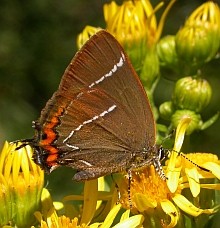 White-letter Hairstreak
White-letter Hairstreak
Satyrium w-album© Teresa Farino• Best year since the study began for Dusky Large Blue (Maculinea nausithous). Not only were some 20 individuals seen in early July at the site we have been monitoring since 1989, but we also located a single male in the same meadow as the Bog Fritillary in northern León, some 10km distant from the former location as the crow flies, albeit that would be over mountains almost 2,000 m high! The larval host plant – Great Burnet (Sanguisorba officinalis) – occurs in some quantity here, and if the requisite ants are also present, it is possible that a new colony might become established in years to come. Sadly, however. it is very likely that this wet meadow habitat will be destroyed within the year by the impending carriageway improvements to the N-621, despite the fact that we have informed the powers that be of the presence of this Annex II (EU Habitats Directive) butterfly here;
• A new Picos locality for Large Blue (Maculinea arion), at around 400 metres in the southern foothills of the range (Cantabria), but no individuals seen elsewhere in the area in 2009;
• A new locality for White-letter Hairstreak (Satyrium w-album) in western Cantabria, at around 1,300 metres;
• Continued presence of Brown Hairstreak (Thecla betulae) in its lowland Cantabrian colonies, with the presence of ovipositing females an encouraging sign.
Macromoths
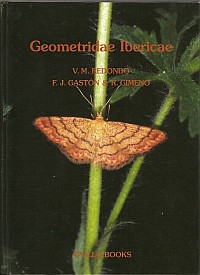 Geometridae Ibericae
Geometridae IbericaeA distinct improvement in numbers of species and their abundance was seen in 2009 with respect to 2008, both for day-flying species and at light (Robinson trap with 80W MV bulb).
The publication of the long-awaited Geometridae Ibericae (Redondo, V. M, Gastón, F. J. & Gimeno, R.; Apollo Books) last year has helped enormously in the identification of some species, although the plates depict half-moths, which can be a bit off-putting. Nonetheless, in cases where the external morphological characteristics were not sufficiently distinctive, specimens were collected and sent to Colin Plant for examination of their genitalia, as were any doubtful specimens from other families.
As a result, we added no less than 19 new species to our Picos list (the rather exotic common names for some of the geometrids are courtesy of Patrice Leraut’s Moths of Europe. Volume II. NAP Editions, published in 2009):
New Species of Macromoths for the Picos de Europa Lepidoptera Study in 2009
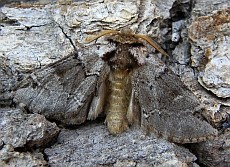 Indistinct Marbled Brown
Indistinct Marbled Brown
Drymonia obliterata© Teresa Farino Notodontidae
Drymonia melagona (= D. obliterata; Indistinct Marbled Brown)
Geometridae
Ascotis turcaria (= A. selenaria; Lunar Beauty))
Cataclysme riguata (Pale Herringbone)
Crocota peletieraria (Pale Dyer) – males day-flying
Epione repandaria (Bordered Beauty)
Eupithecia dodoneata (Oak-tree Pug)
Idaea seriata (Small Dusty Wave)
Perizoma hydratatum (= P. hydrata; Canted Rivulet)
Rhodostrophia calabra (Narrow Rose-banded Wave) – day-flying
Tephronia sepiaria (= T. cremiaria; Dusky Carpet)
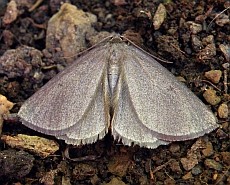 Male Pale Dyer
Male Pale Dyer
Crocota peletieraria© Teresa FarinoNoctuidae
Blepharita satura (Beautiful Arches)
Emmelia trabealis (Spotted Sulphur) – day-flying
Emmelia viridisquama – day-flying
Hadena andalusica
Nola cicatricalis
Nycteola columbana
Rhizedra lutosa (Large Wainscot)
Shargacucullia thapsiphaga
Spodoptera exigua (Small Mottled Willow)
2009 highlights
• Pale Dyer is endemic to the Cordillera Cantábrica and Pyrenees, and we located a good colony in damp, south-facing haymeadows at an altitude of approximately 1,100 m in late July. Only the distinctive blue-grey males fly by day (looking much like Dusky Large Blues at first sight, which had me going there for a minute!), while the smaller, white females are apparently attracted to light;
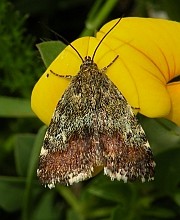 Emmelia viridisquama© Teresa Farino• The collection of a specimen of Small Dusty Wave at light in western Cantabria is of interest as this geometrid is essentially a coastal species in northern and eastern Iberia, and this locality lies more than 50km from the sea;
Emmelia viridisquama© Teresa Farino• The collection of a specimen of Small Dusty Wave at light in western Cantabria is of interest as this geometrid is essentially a coastal species in northern and eastern Iberia, and this locality lies more than 50km from the sea;
• Emmelia viridisquama is considered to be very rare in the Iberian Peninsula, according to J. A. Calle’s Noctuidos Españoles (1982), which is currently in the process of being revised by a team led by the great man himself, at the University of Murcia. In fact, Noctuidae Europaeae, which refers to it as Acontia viridisquama, gives a world distribution as an east-west belt across the centre of the Iberian Peninsula, extending into southern France. We recorded this diminutive day-flying noctuid, which feeds on species of Malva, from two localities in 2009, both at around 1,300m, in south-facing haymeadows on limestone, to the south of the Picos proper, but 35 km apart. Both the typical form (illustrated here) and the almost completely brown f. obscura were observed;
• Cantabria, which is the principal moth-trapping area of our study, appears to be very under-recorded for moths, as a glance at the maps in both Noctuidos Españoles and Geometridae Ibericae will confirm. I haven’t had the time as yet to check the Geometridae Ibericae maps for all 192 geometrids on our Picos list, but in terms of the new species recorded in 2009, Lunar Beauty, Pale Herringbone, Oak-tree Pug, Canted Rivulet, Narrow Rose-banded Wave and Dusky Carpet would all appear to be new for the province.
Don’t forget that in Spain it is ILLEGAL to use a butterfly net or moth trap without a permit from the relevant authorities, even if you do not take specimens.
Related Information:
Details of Teresa's annual butterflies and moths holiday in the Picos de Europa
Read more blog posts